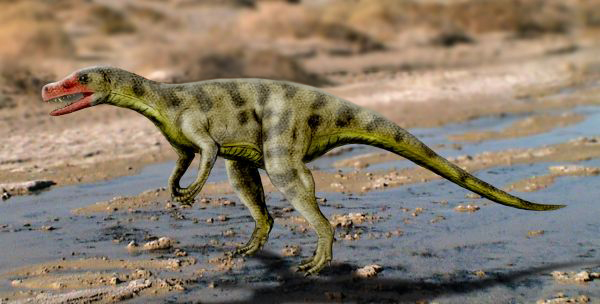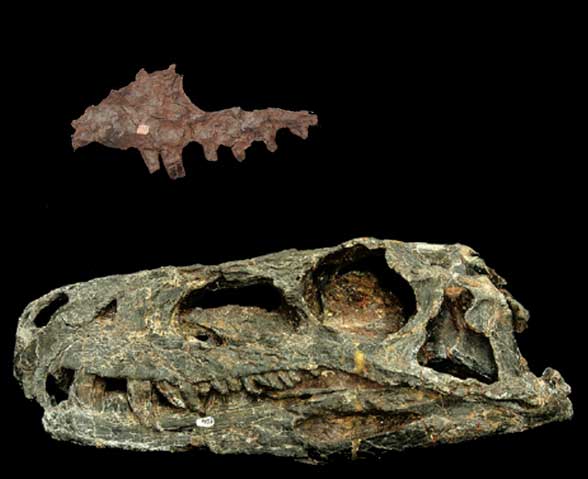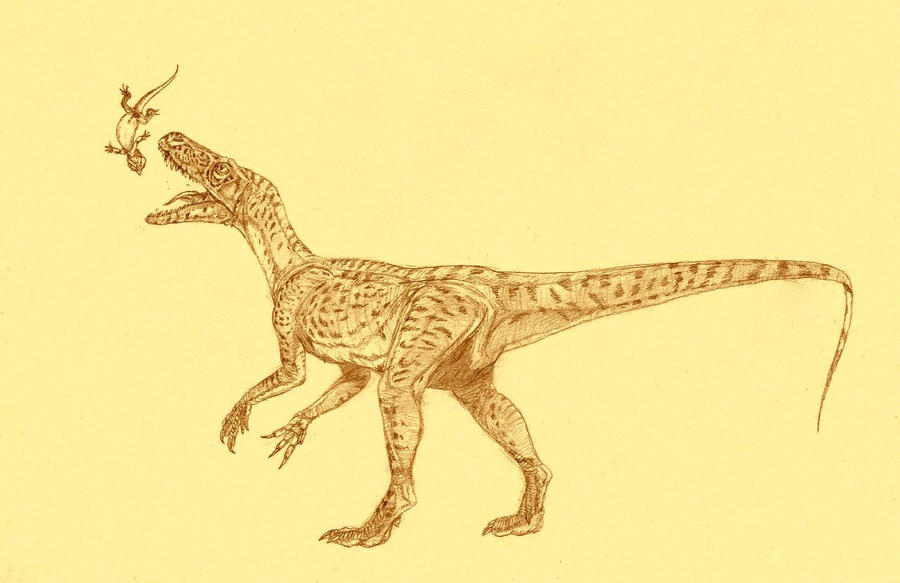[Recent Entries][Archive][Friends][User Info]
March 24th, 2012
| March 24th, 2012 | |
|---|---|
| 01:19 pm [industrialterro] [Link] |
Pisanosaurus Pisanosaurus (meaning "Pisano lizard") is a genus of primitive ornithischian dinosaur from the Late Triassic of what is now South America. It was a bipedal herbivore described by Argentine paleontologist Rodolfo Casamiquela in 1967. Only one species, the type, Pisanosaurus mertii, is known, based on a single partial skeleton. The fossils were discovered in Argentina's Late Triassic Ischigualasto Formation, which dates to about 228 to 216.5 million years ago. The exact classification of Pisanosaurus has been the topic of debate by scientists for over 40 years; the current consensus is that Pisanosaurus is the oldest known ornithischian, part of a diverse group of dinosaurs which lived during nearly the entire span of the Mesozoic Era. Based on the known fossil elements, Pisanosaurus was a small, lightly built dinosaur approximately 1 m (3 ft 3 in) in length. Its weight was between 2,27–9,1 kg (5–20 lb). These estimates vary due to the incompleteness of the fossil. The tail of Pisanosaurus has been reconstructed as being as long as the rest of the body, based on other early ornithischians, but as a tail has not been recovered, this is speculative. It was bipedal and, like all other known ornithischians, was probably herbivorous. Pisanosaurus mertii was described by Argentine paleontologist Rodolfo Casamiquela in 1967. The name Pisanosaurus honors Juan A. Pisano, an Argentine paleontologist, while saurus is derived from the Greek σαυρος, meaning "lizard". Pisanosaurus is known from a single fragmented skeleton found in Argentina. It is based on a specimen given the designation PVL 2577, which was discovered in the Ischigualasto Formation. Pisanosaurus is very basal within Ornithischia; the postcrania seem to lack any good ornithischian synapomorphy; it was even suggested by Paul Sereno in 1991 that the fossil is a chimera. However, recent studies suggest that the fossils belong to a single specimen. Pisanosaurus has been classified either as a heterodontosaurid or as the earliest known ornithischian. A 2008 study placed Pisanosaurus outside of (and more basal than) Heterodontosauridae. In this study, Pisanosaurus is the earliest and most primitive ornithischian. Pisanosaurus is the type genus of the Pisanosauridae, a family erected by Casamiquela in the same paper which named Pisanosaurus. The Pisanosauridae family has fallen into disuse, as a 1976 study considered the group synonymous with the already named Heterodontosauridae.
Размеры тела в сравнении с человеком:
Tags: Вымершие рептилии, Триас, авеметатарзалии, архозавроморфы, архозавры, диапсиды, динозавроморфы, динозавры, птицетазовые |
| Time | Event |
| 01:53 pm [industrialterro] [Link] |
Procompsognathus Procompsognathus ( The name is derived from Compsognathus meaning 'elegant jaw' (Greek kompsos/κομψος meaning "elegant", "refined" or "dainty" and gnathos/γναθος meaning "jaw"), which was a later (Jurassic) dinosaur. The prefix προ/pro implies "before" or "ancestor of", although this direct lineage is not supported by subsequent research. Procompsognathus may have been about 1 meter long (3.3 ft). A biped, it had long hind legs, short arms, large clawed hands, a long slender snout with many small teeth, and a stiff tail. It lived in a relatively dry, inland environment and may have eaten insects, lizards, and other small prey. While it is undoubtedly a small, bipedal carnivore, the extremely poor preservation of the only known Procompsognathus fossil makes its exact identity difficult to determine. It has historically been considered a theropod dinosaur, though some, such as Allen (2004), have found Procompsognathus to be a primitive, non-dinosaurian ornithodiran. Sereno and Wild (1992) stated that the holotype specimen consisted of fossils from two separate animals. They referred the skull to the primitive crocodylomorph Saltoposuchus, and the remainder of the skeleton to a coelophysoid related to Segisaurus. Rauhut and Hungerbuhler (2000) noted features of the vertebrae which suggest that Procompsognathus may be a coelophysid or ceratosaur, and Carrano et al. (2005), in their re-study of the related genus Segisaurus, found both Segisaurus and Procompsognathus to belong to the Coelophysidae within Dinosauria.
Размеры тела в сравнении с человеком:
Tags: Вымершие рептилии, Триас, авеметатарзалии, архозавроморфы, архозавры, диапсиды, динозавроморфы, динозавры, тероподы, целофизиды, ящеротазовые |
| Time | Event |
| 02:18 pm [industrialterro] [Link] |
Riojasaurus Riojasaurus (meaning "Rioja lizard") was a herbivorous prosauropod dinosaur named after La Rioja Province in Argentina where it was found by José Bonaparte. It lived during the Late Triassic and grew to about 10 metres (33 ft) long. Riojasaurus is the only known riojasaurid to live in South America. Riojasaurus had a heavy body, bulky legs, and a long neck and tail. Its leg bones were dense and massive for a prosauropod. By contrast, its vertebrae were lightened by hollow cavities, and unlike most prosauropods, Riojasaurus had four sacral vertebrae instead of three. It probably moved slowly on all fours and was unable to rear up on its back legs. The nearly equal length of the fore and hindlimbs is also suggestive of an obligatorily quadrupedal gait. No skull was found with the first skeleton of Riojasaurus, although a well-preserved skull attributed to Riojasaurus was found later. The teeth of Riojasaurus were leaf shaped and serrated. The upper jaw contained 5 teeth at the front, with 24 more behind them in a row that ended under the eyes. Comparisons between the scleral rings of Riojasaurus and modern birds and reptiles suggest that it may have been cathemeral, active throughout the day at short intervals. Many scientists think that Riojasaurus was closely related to Melanorosaurus, the largest prosauropod known from the Triassic-Early Jurassic period. However, studies at Bristol University, England, suggest that it is unique in some key ways, such as the longer bones in its neck. It is certainly quite different from other prosauropods found in the Los Colorados Formation of Argentina. Due to their size and limb anatomy Riojasaurus and the possibly related Melanorosaurus have been considered close relatives of the earliest sauropods. However, if the hypothesis proposed by Peter Galton and Paul Sereno is correct -- namely, that prosauropods and true sauropods share a common ancestor rather than the former giving rise to the latter -- then commonalities shared by Riojasaurus and true sauropods are likely due to convergent evolution.
Размеры тела в сравнении с человеком:
Tags: Вымершие рептилии, Триас, авеметатарзалии, архозавроморфы, архозавры, диапсиды, динозавроморфы, динозавры, завроподоморфы, прозавроподы, ящеротазовые |
| Time | Event |
| 02:36 pm [industrialterro] [Link] |
Sanjuansaurus Sanjuansaurus — род динозавров из семейства эрреразаврид, обнаруженный в 2010 году на территории современной Аргентины. Голотипом является экземпляр PVSJ 605. Представлен единственным видом — Sanjuansaurus gordilloi. Sanjuansaurus ("San Juan Province lizard") is a genus of herrerasaurid dinosaur from the Late Triassic-age Ischigualasto Formation of northwestern Argentina. It is known from and based on an associated and partially articulated partial skeleton (PVSJ 605) consisting of a jaw fragment, most of the vertebral column from the axis to the anterior tail, the shoulder blades, an ulna, part of the pelvis, most of the long bones of the legs, and a few other bones. PVSJ 605 was found in the Cancha de Bocas Member near the base of the Ischigualasto Formation, in Ischigualasto Provincial Park in San Juan. This horizon dates to approximately 231.4 Ma, during the late Carnian Stage of the Late Triassic. Sanjuansaurus was named and described in 2010 by Oscar Alcober and Ricardo Martinez. The type species is S. gordilloi after Raul Gordillo, the head fossil preparator and artist of the San Juan Museum. Sanjuansaurus was a contemporary of other early dinosaurs including Chromogisaurus, Eoraptor, Herrerasaurus, and Panphagia. It was comparable in size to a medium-sized Herrerasaurus, with a thigh bone length of 395 millimetres (15.6 in). Alcober and Martinez performed a phylogenetic analysis and found Sanjuansaurus to be a herrerasaurid.
Размеры тела в сравнении с человеком:
Обломок челюсти вверху, нижний цельный череп принадлежит герреразавру.
Tags: Вымершие рептилии, Триас, авеметатарзалии, архозавроморфы, архозавры, герреразавриды, диапсиды, динозавроморфы, динозавры, тероподы, ящеротазовые |
| Time | Event |
| 02:51 pm [industrialterro] [Link] |
Saturnalia Сатурналия - самый ранний из известных травоядных динозавров. Первоначально его считали ранним прозауроподом. Теперь установлено, что он более примитивен, чем прозауроподы, поэтому классифицируется как ранний завроподоморф. По трём почти полностью сохранившимся скелетам мы можем воссоздать внешний облик этого изящного животного с длинной шеей и длинным хвостом. Голова маленькая, зубы грубо зазубреные, приспособленые к размалыванию растительной пищи. Тело обтекаемое, ноги тонкие. Кости таза примитивные (этот род находится на границе отряда динозавров), но голеностопные кости такие же, как у современных ему травоядных динозавров. По происхождению он был очень близок прозауроподам и зауроподам. Своё имя сатурналия получила в честь римского праздника зимнего солнцестояния, когда и был найден его скелет. Saturnalia was originally named on the basis of three partial skeletons. The holotype, MCP 3844-PV, a well-preserved semi-articulated postcranial skeleton, was discovered in mid-summer at Sanga da Alemoa, Rio Grande do Sul, in Brazil, in the geopark of Paleorrota. The two paratypes are MCP 3845-PV, partial skeleton including natural cast of partial mandible with teeth and some postcranial remains, and MCP 3846-PV, partial skeleton including postcranial remains. All specimen were collected in the "Wald-Sanga" (also known as "Sanga do Mato") locality from the Alemoa Member of the Santa Maria Formation (Rosário do Sul Group), dating to the Carnian faunal stage of the early Late Triassic, about 225 million years ago. A partial femur from the Carnian Pebbly Arkose Formation of Zimbabwe was also attributed to the genus. It is one of the oldest true dinosaurs yet found. It probably grew to about 1.5 meters (5 ft) long. The primitive nature of Saturnalia, combined with its mixture of sauropodomorph and theropod characteristics, has made it difficult to classify. Paleontologist Max Cardoso Langer and colleagues, in their 1999 description of the genus, assigned it to the Sauropodomorpha. However, in a 2003 paper, Langer noted that features of its skull and hand were more similar to the sister group of sauropodomorphs, the theropods, and that Saturnalia could at best be considered a member of the sauropodomorph "stem-lineage", rather than a true member of that group. José Bonaparte and colleagues, in a 2007 study, found Saturnalia to be very similar to the primitive saurischian Guaibasaurus. Bonaparte placed the two in the same family, Guaibasauridae. Like Langer, Bonaparte found that these forms may have been primitive sauropodomorphs, or an assemblage of forms close to the common ancestor of the sauropodomorphs and theropods. Overall, Bonaparte found that both Saturnalia and Guaibasaurus were more theropod-like than prosauropod-like. However, all more recent cladistic analyses found it to be a very basal sauropodomorph, possibly guaibasaurid, as the family was found to nest in a basal position within Sauropodomorpha.
Размеры тела в сравнении с человеком:
Tags: Вымершие рептилии, Триас, авеметатарзалии, архозавроморфы, архозавры, диапсиды, динозавроморфы, динозавры, завроподоморфы, тероподы, ящеротазовые |
| Time | Event |
| 03:06 pm [industrialterro] [Link] |
Staurikosaurus Ставрикозавр (Staurikosaurus) — монотипный род тероподов позднего триасового периода из семейства Herrerasauridae, один из первых динозавров планеты. Единственный вид в роде - Staurikosaurus pricei. Родовое имя динозавра "ставрикозавр" связано с названием созвездия Южный Крест, изображённого на гербе Бразилии и видимого, наблюдаемого только в Южном полушарии, как свидетельство редких находок динозавров в Южном полушарии. Видовое имя pricei посвящено бразильскому палеонтологу Л.И.Прайсу (Llewellyn Ivor Price), обнаружившему скелет ставрикозавра. Ставрикозавр обитал в карнийском веке верхнего триасового периода, около 225 млн. лет назад. Он достигал высоты 2,25 м и длины 80 см и весил около 30 кг. Единственная находка ставрикозавра очень не полная: состоит из большей части позвоночника, фрагментов ног и нижней челюсти. Реставрация ставрикозавра выполнялась исходя из предположения, что динозавр на заре эпохи не мог быть очень сложным и иметь узко-специализированные органы. Поэтому ставрикозавра изображают обычно с простыми 5-ю пальцами передних и задних конечностей. Однако найденных фрагментов достаточно, чтобы судить о том, что ставрикозавр был довольно быстрым хищником. Ставрикозавр достигал длины 2,25 м и высоты 80 см и весил около 30 кг. Единственный экземпляр ставрикозавра был обнаружен при раскопках в районе Рио-Гранде-до-Сул в Южной Бразилии. Эдвин X. Кольберт из Американского музея естественной истории дал научное описание виду в 1970 году. Этот мелкий древний динозавр жил в позднем триасе, примерно 225 миллионов лет назад. До середины 20 века открытием останков динозавров изобиловало только Северное полушарие Земли, в то время как в Южном полушарии находок скелетов древних ящеров практически не было. Поэтому название динозавра происходит от созвездия Южного креста - в ознаменование находки динозавра в Южном полушарии, ведь до этого подобные находки были весьма редким явлением. Поэтому ставрикозавр - ящер "Южного креста". Ставрикозавр мог достигать примерно 2 метров в длину, что позволяет считать его достаточно мелким в сравнении с другими, более поздними динозаврами, и весил около 30-35 кг – это был очень легкий ящер. Зубы были заостренными, так что ставрикозавр скорее всего являлся хищником. Челюсть ящера имела интересное строение: она могла слегка выдвигаться вперед а также задвигаться глубже в пасть. Вероятно, таким образом, ставрикозавру было легче удерживать попавшую ему в пасть добычу. Относительно небольшое тело ставрикозавра венчала большая голова; хвост был тонким и длинным. Скорее всего, он служил своеобразным рулём, помогая ставрикозавру во время бега. Передвигался этот динозавр очень быстро. Палеонтологи не без оснований считают, что ставрикозавр мог быть самым быстрым ящером своего времени: на это указывают его длинные и сильные задние конечности. Немногое известно об этом мелком животном, но это очень важная находка, так как до самого последнего времени ставрикозавр считался самым древним из известных динозавров. Судя по его внешнему виду, он больше походил на мелких хищных теропод, но некоторые черты строения скелета роднили его с растительноядными прозауроподами. Предполагалось, что ставрикозавр был близок к тем древнейшим ящерам, от которых путём дивергенции произошли обе группы ящеротазовых динозавров. Однако в 1984 году в Аризоне в Пеинтед Дезерт, США, были найдены остатки еще более древнего динозавра и он оказался настолько похожим на ранних прозауропод, что стало ясно, что группа прозауропод эволюционно древнее, чем ставрикозавры. Так как ставрикозавр был весьма древним динозавром, и известные ученым части его скелета имеют очень примитивное строение, то можно сделать вывод, что и недостающие части его скелета были столь же примитивны. Таким образом, мы можем реконструировать облик ставрикозавра и предположить, что стопа и кисть этого ящера были пятипалыми, то есть всё ещё находились на ранней стадии эволюции (по другим данным верхние конечности ящера были украшены четырьмя пальцами).
Размеры тела в сравнении с человеком:
Tags: Вымершие рептилии, Триас, авеметатарзалии, архозавроморфы, архозавры, герреразавриды, диапсиды, динозавроморфы, динозавры, тероподы, ящеротазовые |
| Previous Day | 2012/03/24 [Archive] |
Next Day |





























